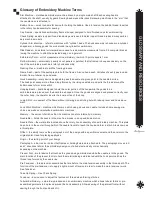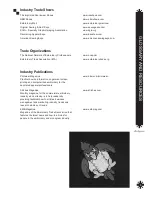
EM
BR
O
ID
ER
Y
S
O
FT
W
A
R
E
2
Digitizing Basics
Choosing a Stitch Type
•
Satin or Complex Fill - The easiest way to decide what stitch type to use is to measure the maximum width
that will be generated when the object is digitized. In general, satin stitch is suitable for widths less then
8mm. If wider, use complex fill.
Color changes and trims
• It is best to minimize color changes and trims where possible without compromising the design. Before
digitizing your design, try to decide on the minimum number of colors that you will need. Sometimes it is not
necessary to use all the colors.
Consider the movement of the fabric in the hoop
• The way the design looks on the screen is not always the way it will look when embroidered. Fabric moves
within the hoop during the embroidery process creating distorted shapes and unwanted gaps.
• The degree of movement of fabric depends on these things:
- the type of fabric (loose weave, sheer fabric and knits have more movement)
- the size of the design (the bigger the design the more movement)
- the sewing sequence
- the stitch angles (with the grain or against the grain of the fabric)
- the density of the design
- the hooping process (if the fabric was stretched too much or not taut enough)
- the backing used (not enough or right type of backing for material)
Planning the digitizing process
• Proper planning the order in which the design will be stitched will help limit fabric movement, unnecessary
jumps and trims.
• The sewing sequence order, working in layers with items in the background being digitized first and then
moving to the foreground. Also working from the center of the design outwards.
• Proper placement of entry and exit points along with the stitch angle will improve the sewing process of the
design.
Use underlay to stabilize fabric
• Proper usage of underlay gives body and stability to the embroidery.
• Prevents stitches from sinking into the fabric.
Pull Compensation
• During the embroidery process, the fabric will pulled slightly by the force of the stitching. This is very com
-
mon is stretchy fabrics like knits. Pull compensation lengthens the stitches to compensate for the pulling.
• Pull compensation for T-shirts should be set at .2mm and for stretchier knits .25 - .3mm. This will depend
on the ounce weight of the garment.
Digitizing shapes
• Slightly overlap shapes when digitizing to prevent gaps between objects due to fabric movement.
• Overlapping the shapes, also gives more depth to the design.
• When digitizing shapes slightly exaggerate the shape making it a little bigger to compensate for the push
and pull of the fabric.
• For a circuluar shape widen the sides and shorten the top and bottom. It will appear oval on screen but will
embroider round.
Summary of Contents for GS1501
Page 30: ...GETTING STARTED 28 ...
Page 31: ...GETTING STARTED 29 The Control Panel Display ...
Page 62: ...EMBROIDERY BASICS 28 Notes ...
Page 64: ...MACHINE BASICS 2 ...
Page 65: ...MACHINE BASICS 3 ...
Page 70: ...MACHINE BASICS 8 ...
Page 71: ...MACHINE BASICS 9 ...
Page 78: ...MACHINE BASICS 16 Notes ...













































